During this past summer whenever I was outdoors and the birds weren’t showing I took pictures of the dragonflies that I spotted. I’ve managed to identify some of them but I am certainly not an expert. As I’ve mentioned before, they are “a serious identification challenge and figuring them out is an interesting, though frustrating, way to spend that middle part of the day.” Now seems like a good time to share some of what I’ve learned (and some of what I haven’t).
To identify dragonflies I use the only dragonfly-centric field guide I own, Dragonflies Through Binoculars. Usually I just flip through the pictures until I find one that looks like the one in the picture I took and then I look it up on the web if I want more information. This works maybe half the time so at the end of this post will be several pictures of dragonflies that I can’t identify. Please help!
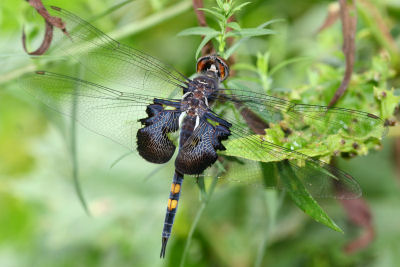
Black Saddlebags
The Black Saddlebags, or Tramea lacerata, was a rather easy dragonfly to identify. The black at the base of its hind wings made it a saddlebags (so-called because the markings look like a horse’s saddlebags) and the two white dorsal spots clinched the species identification. The yellow-brown face color makes this particular individual (which only posed so nicely because I came upon it just after sunrise before it had a chance to warm up) a female or a juvenile male.
The next dragonfly didn’t seem to be in my book. So I went web surfing and now I am pretty sure it is either a female Ruby-faced Meadowhawk or a female Cherry Meadowhawk, so I’ll leave it as a Sympetrum species. The picture I am basing this rough identification off of is here.
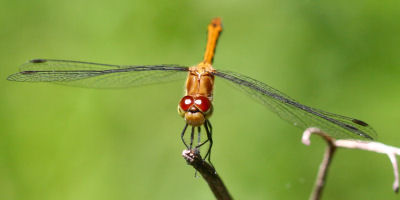
Sympetrum sp.
Unlike the unfortunately not-completely-identified dragonfly above the next pair were easy to identify. They are Blue Dashers (Pachydiplax longipennis) and they are busy making more of their kind. The day I took the picture I also witnessed several females laying eggs and watched males battle over territories, an activity ably described in Dragonflies Through Binoculars as consisting of a male dragonfly “confronting other males with abdomen raised. During territorial battles, each male tries to get under his opponent and force him up and away from the water.” And you thought the dragonflies were just flying around randomly!
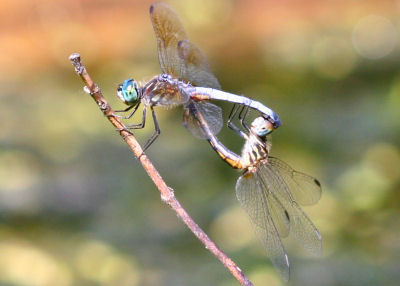
Blue Dashers lovin’
Now, as I promised, here are dragonflies I haven’t figured out yet. I don’t know if I just missed them in the guide or what. If you know what they are please post their identity in the comments.
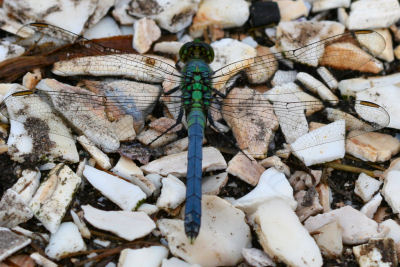
This one was in the Adirondacks
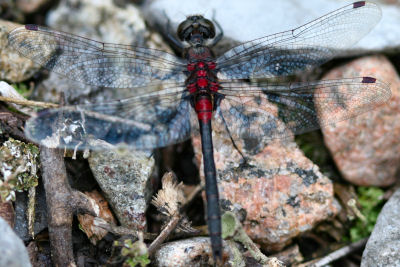
This should be easy to identify, right?
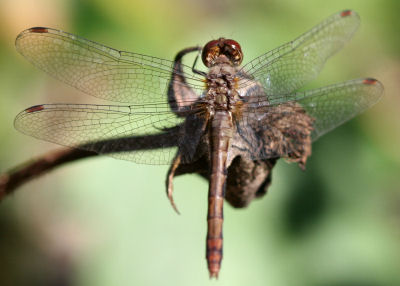
This one was rather small.
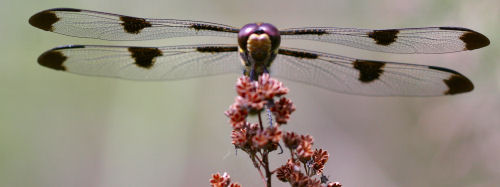
I have way too much more to learn.
Advance thanks for any help you can offer!











Those are some great dragonfly photos. It is great to be able to identify plants and insects as well as birds. We are just starting to identify butterflies and plants, but there are so dang many of them! Good luck with the I.D.s on those guys!
Great shots! Check out http://www.njodes.com for a great online field guide. Forget those plates in “From Binoculars.” They’re not very good. “Dragonflies and Damselflies of Massachusetts” or the Stokes Beginner’s Guide are both good with the former being ideal.
Unknown 1: Probably a male Eastern Pondhawk
2: Crimson-ringed Whiteface (although I think there is a red form of Belted Whiteface that might occur up by you)
3: Another Sympetrum?
4: Too tough to call, any other angles?
I really enjoy dragonflies but am still an amateur with them. I’d love to see one of those “saddlebagged” dragonflies. That’s a new one for me.
Carolyn H.
http://roundtoprumings.blogspot.com
@Veery: Good luck and thanks!
@Patrick: Thanks for the info and I’m going to have to start calling these posts “Patrick, Help!”
@Carolyn: They are one of the few families I can safely ID…those saddlebags really stick out.
Patrick is correct: pondhawk, whiteface (although…it’s helpful if you always note time and place; whitefaces are often early-season, northern species), probably a female Sympetrum, but more info would be handy. And the last is a Twelve-spotted Skimmer.
i,m sri lankan.i like dragonfly & study about them.nice shot.
this spp. different for sl ssp.